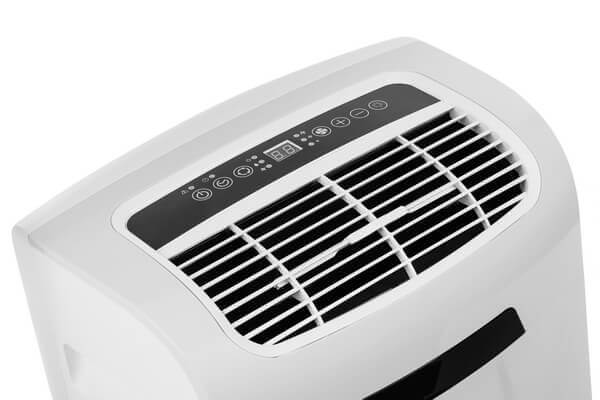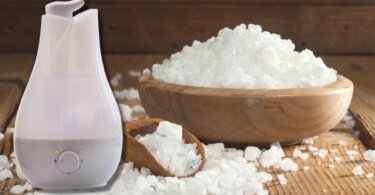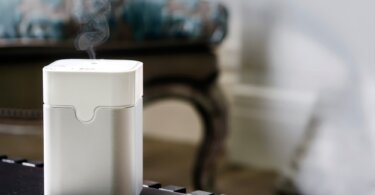
If you live in a hot part of the world, we’re sure you are already aware of the nasty mold. In humid conditions, your stuffy basement is the softest target for mildew to strike on.
Does your basement smell musty and feel damp? There’s your first warning. What appears next is the gross green, blue, black, or pink patches spreading across your walls, like a scene from a horror movie. Scary, isn’t it?
Soon after, the paint on your walls starts to crack and peel off. Or something worse, like dust mites that cause allergies.
So what to do when you face the same situation? Get the best dehumidifier for the basement to get rid of the nasty mold for good.
- Top Rated Basement Dehumidifier Reviews 2024
- 1. hOmeLabs 4500 Sq Ft Dehumidifier
- 2. Vremi 50 Pint Dehumidifier
- 3. TOSOT 70 Pint Dehumidifier
- 4. Ivation 70 Pint Dehumidifier
- 5. MIDEA MAD50C1ZWS Dehumidifier
- 6. Inofia 30 Pint Dehumidifier
- 7. Frigidaire FFAD6022W1 Dehumidifier
- Dehumidifier for Basement Buying Guide
- What Causes Dampness in the Basement
- Why Do You Need a Dehumidifier For Your Basement?
- Basement Dehumidifier Types
- How Do Basement Dehumidifiers Work?
- What To Look For When Choosing a Dehumidifier For Your Basement?
Top Rated Basement Dehumidifier Reviews 2024
1. hOmeLabs 4500 Sq Ft Dehumidifier
One of their most popular models, the hOmeLabs Dehumidifier efficiently gets rid of moisture and bad odor from areas as large as 4500 sq. ft. The sleek design is likely to fit any setting without appearing unpleasant to the sight.
This model holds up to 1.8 gallons of water, which is not bad for such a compact unit. It also shuts off on its own when you need to unload the water bucket. You can empty it yourself or use the drain hose outlet for more convenience.
hOmeLabs noticeably reduces moisture, allergens, and foul odor from the atmosphere through its pump compressor. The fan inside the system is reasonably quiet and has a Turbo mode, which means an increased fan speed for maximum dehumidification.
You can also move this unit with ease as it comes with built-in wheels. But, here’s the catch. Unlike some other humidifiers, this one doesn’t turn off automatically after reaching the set humidity level.
Pros:
- Sleek design
- Auto-shutoff on reaching maximum tank capacity
- Easy to handle
- Turbo mode for higher efficiency
Cons:
- Limited water tank capacity
- Not whisper quiet
2. Vremi 50 Pint Dehumidifier
If you want your basement dehumidifier to spell convenience, without compromising on style, the Vremi 50 Pint Dehumidifier might be a good option. The unit removes moisture, dirt, and other nastiness from the air using its powerful filter that is super easy to clean.
It maintains the levels of wetness in the air that discourages any further growth of mold and mildew. The water tank can hold 1.8-gallons at a time. Vremi declares the unit to be ideal for spaces ranging from 3000 to 4000 sq. ft. Just set the unit to the required humidity level, and leave it to run until the tank needs to be emptied again.
If you don’t want to empty the tank yourself, you can use the drain hose connector without any trouble. What’s more, the fixed wheels and handles make the unit more convenient to handle and move. On the downside, it’s relatively louder than others. It almost sounds like a window AC running in a room. So, if you are used to some noise, it won’t be a problem.
Pros:
- Convenient and modern design
- Easy handling
- Auto-defrost
Cons:
- Sounds similar to an air conditioner
- Might heat up in a hot climate
3. TOSOT 70 Pint Dehumidifier
TOSOT Dehumidifier effectively removes mildew and other allergens from your basement while still staying light on your pocket. The manufacturer claims the dehumidifier to save energy and lower your monthly utility bill.
With a 1.5-gallon water tank, this model cleans the air in spaces as large as 4500 sq. ft. You will find a digital display on the top of the unit for better control, and wheels at the bottom for easy handling. The system shuts down once the tank is full. It also restarts and restores on its own after a power outage. Moreover, a filter light will pop on the display screen to indicate that it’s time to clean the filter.
After you attach a drain hose, the gravity drain empties the tank continuously, without a snag. As the set-up relies on gravity, you will have to slope the drain hose below the drain nozzle on the unit. If you find the noise annoying, this product is just for you as it remains quiet at all three settings.
Pros:
- Energy Star certified
- Digital display controls
- Filter cleaning indicator light
- Auto-restart and auto-restore
Cons:
- You need to drain the water bucket frequently
4. Ivation 70 Pint Dehumidifier
If you are looking for a top-notch dehumidifier for a large basement that is both compact and powerful, this one might be it. Ivation Dehumidifier eliminates any wetness in the surroundings as vast as 4500 sq. ft. It’s amazingly easy to set up and operate. The LED display makes it easier to set the humidity levels, fan speed, and timer and keeps you informed at all times.
The auto-defrost and auto-restart options keep you from worrying about one more thing. You can adjust the fan on either of the two speeds in the dehumidifier. The permanent filter is easily cleanable, so you don’t have to go through the trouble of filter replacements.
However, a limited water capacity of the tank might be a problem for users who are away from home for longer periods.
Pros:
- Compact and powerful
- Auto-shutoff feature
- LED display for indication
Cons:
- A few reviews reported failed auto-defrost systems
- Limited water capacity
5. MIDEA MAD50C1ZWS Dehumidifier
The MIDEA MAD50C1ZWS Dehumidifier looks classy and cleans your basement of any mold, musty smells, and other nasties breeding around the space. It’s energy efficient and cleans large areas up to 4500 sq. ft.
The system efficiently cleans the air of excessive water, fusty smells, and allergens that might put your and your family’s health to risk. Once the water tank fills to the brim, you can empty it manually or attach a hose drain. The unit alerts you when you need to clean the filter. It also has auto-restart and auto-restore options for more painless usage.
The manufacturer claims the dehumidifier to be quiet enough to use while sleeping, even on Turbo mode. However, some users have reported otherwise.
Pros:
- In-built wheels and handle
- Turbo mode
- Filter cleaning indicator
Cons:
- Not too quiet
6. Inofia 30 Pint Dehumidifier

The Inofia Dehumidifier is small and powerful, made to dehumidify small-sized basement or other spaces in the house. This model has a polished and compact look but does what it’s meant to do.
The product maintains the humidity of a 1000 sq. ft basement without much noise or trouble. It automatically turns off on reaching the set humidity levels and turns on when it’s needed again. You have an option to adjust the compressor fan between the two fan speeds, depending on the humidity levels and climate on a particular day. The temperature, humidity, and other information appear on the LCD display for ease of use.
After the water tank reaches its capacity, you can empty it manually or use the gravity-fed drain hose for self-drainage. The auto-defrost system makes sure that the dehumidifier works equally efficiently in colder climates as well. What caught our attention is the troubleshooting tips the machine gives on the LCD in case of any malfunctioning. Another good thing is the delay in the compressor starting time to prevent overheating of the unit.
Pros:
- Auto-shutoff on reaching set humidity level
- Troubleshooting tips
- Three-minute compressor delay
Cons:
- Not suitable for larger basements
- Less fan speed options
7. Frigidaire FFAD6022W1 Dehumidifier
This Frigidaire Dehumidifier features a smart design with a fairly large water capacity of 60 pints. It comes with wheels and handles on the top and the sides for easy movement. You can use this model in very wet places, such as attics and basements. You can set the fan on either of the two fan speeds, depending on your requirement and the climate on a particular day.
This unit automatically shuts off when the water bucket is full and needs emptying. But, you also have the possibility to choose the ‘continuous draining option’ to prevent yourself from emptying the bucket all the time. The mesh filter is also easy to clean and wash to maintain the fresh air in the basement.
Pros:
- Relatively large water tank capacity
- Easy to move
- Exact humidity level control
- Full tank shut off
Cons:
- A bit loud
- Break down more often than other reviewed dehumidifiers
Dehumidifier for Basement Buying Guide
The first step to take in the fight against potential fungus is to measure and assess the level of humidity in the basement. This parameter will help you easily determine why moisture gets into your room so often and will basically allow selecting a powerful dehumidifier.
Please note that you will also need to buy a special device to measure humidity level – hygrometer. With this device, you will be able to measure the exact level of humidity in the room, which will help you purchase a suitable dehumidifier.
What Causes Dampness in the Basement
- Lack of ventilation: Basements often lack a ventilation system; ventilation may be installed incorrectly or may be faulty which results in its inability to ensure a constant flow of fresh air into premises. This will cause condensation on the basement ceiling and walls.
- Subsoil water: If your basement is located nearby subsoil waters, increased humidity is most likely caused by them, since any water flow can easily get into such premises. This tough challenge can be easily solved by high-quality waterproofing.
- Inadequate house weather-proofing: If homeowners weather-proofed the house wrong and ignored some factors during the process, then moisture will sleep into the house every time it rains.
- Poor or missing drainage system: There must be a quality drainage system around the house as, without it, the moisture will get into the basement in rainy weather. If the drainage system is installed incorrectly and cannot fully remove water during rain, the water will accumulate in the basement or even flow there. As a result, you will have to pump the water yourself.
Why Do You Need a Dehumidifier For Your Basement?
Most basement owners often face the problem of dampness caused by high humidity. Perhaps, you have experienced a situation when you have a weird and funny feeling of discomfort when going down to the basement.
Excess moisture in the air accumulates as condensation on the walls and ceiling. What is more, increased humidity levels contribute to other problems, such as mold and mildew. Once you get rid of dampness that all basements are prone to, you will also forget about such widespread problems as rust, mold, and allergens. Damp basement ruins your home interior decoration and harms your health; therefore, you must know what to do with it while you still can.
To control excess moisture and condensation, we recommend using a dehumidifier. The dehumidifier can reduce the humidity level and pull accumulated moisture out of your walls. Once you install this device in your home, you’ll know how to dry your basement efficiently and without extra cost.
Read also: How to Reduce Moisture and Humidity in Your Garage
Basement Dehumidifier Types
Two types of dehumidifiers can be used in basements:
- compressor dehumidifier;
- desiccant dehumidifier.
Compressor dehumidifiers first cool down the air stream, causing excess moisture to precipitate in the form of dew and collect in a special tank. Then, the air is heated to the initial temperature. Desiccant dehumidifiers make the airflow pass through the tank with an adsorbent that pulls and retains moisture.
Your choice will depend on when you need to dry your basement: desiccant dehumidifiers work well at low temperatures, and compressor devices are best suited for high temperatures. Many claim that compressor dehumidifiers can operate at a temperature of 39 to 41 degrees Fahrenheit, though according to customer reviews, they start malfunctioning even at ten degrees (when cooling, the water freezes so you need to fix the dehumidifier that’s freezing up and defrost it).
How Do Basement Dehumidifiers Work?
Any basement dehumidifier collects condensate in a special tank. If you missed the alert or simply forgot to empty the tank, the device will automatically turn off and produce a sound alarm. Its safety system will prevent the liquid from overflowing and creating potentially dangerous situations.
If you’re going somewhere, you’d better take advantage of the autonomous operation feature. There is a special drainage pipe built into the device body, which can be used to drain moisture into the sewer. Now, you don’t even need to pour out the condensate – the pump will do it for you.
The dehumidifier is a complex modern appliance but you will not feel it in any way. The device is low-maintenance and does not require frequent check-ups or repairs. You just need to clean filters at regular intervals and follow simple maintenance advice.
What To Look For When Choosing a Dehumidifier For Your Basement?
1. Performance
The main dehumidifier characteristic is moisture removal. This parameter shows how many liters of moisture your device can remove from the air per day.
It is important to select the dehumidifier that will be able to dry all the excess moisture released in the room. Remember that in most cases, manufacturers indicate the dehumidifier performance by measuring the moisture intake at a temperature of 86 degrees Fahrenheit and humidity of 80%, while most residential premises where this equipment is required have the air temperature of 71 F – 75 F with the humidity maintained at 60%. With these parameters, the humidifier is less productive – on average by 20-25%. Keep it in mind when making your choice.
Related article: Best Wall-Mounted Dehumidifiers
2. Operating Temperature Mode
When choosing the dehumidifier, consider its operating temperature ranges.
If your basement is not heated, forecast the temperature inside it during a cold winter. Do not listen to anyone telling you that compressor dehumidifiers retain their dehumidification efficiency at temperatures above 41 degrees. In fact, compressor models are effective at temperatures above 59 F. The higher the temperature, the higher the ability to remove moisture. At temperatures below 50 degrees, this dehumidifier spends most time in the defrosting mode and its dehumidification capacity is almost ineffective.
If the temperature in your basement is below 59 F, it is best to use a desiccant dehumidifier – a household version of the device will work just fine.
3. Air Exchange
This is the most important parameter that only a few people consider when selecting the dehumidifier.
Air exchange (sometimes air flow rate) is measured in cubic meters per hour (m3/h). This parameter shows how much air your dehumidifier will run through the compressor (while drying) within an hour. For effective dehumidification, air exchange (m3/h) must exceed the air space by 2-3 times. Otherwise, the device will not be able to run the moist air through it fast enough regardless of its moisture removal capacity.
For example, if the basement (or living room) area is 60 m3, then select the dehumidifier with an airflow rate (air exchange) of 150-200 m3/h. Then, your basement dehumidification will be effective while the humidity will be maintained at a permanently normal level.
4. Condensation Collection Tank
If you don’t feel like going down to the basement several times a day to drain the condensate from the tank, connect a drainage tube and condensate will not be collected in the tank but will be discharged into the sewer (or wherever you direct the drainage tube).
However, sometimes there is nowhere to direct the drainage tube due to the lack of sewage in the basement. In this case, consider the dehumidifier tank volume. The larger it is, the less maintenance it needs.
5. Power Consumption
Please note that in a damp basement, your dehumidifier may be on most of the time and therefore consume electricity. Dehumidifiers of the same capacity and power can consume absolutely different electricity volumes. This depends on the dehumidifier manufacturer and brand.










